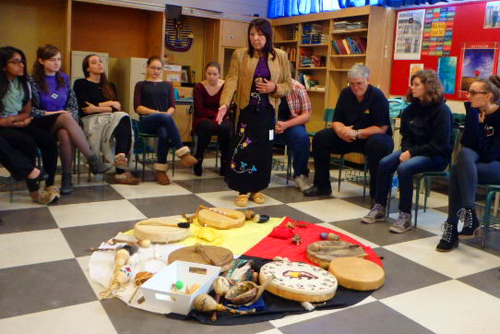 Grade 11 and 12 students in the Current Aboriginal Issues in Canada class at Georgetown District High School created a 'charter' to champion the rights of First Nations, Inuit and Métis people. It addressed social justice and housing.
Grade 11 and 12 students in the Current Aboriginal Issues in Canada class at Georgetown District High School created a 'charter' to champion the rights of First Nations, Inuit and Métis people. It addressed social justice and housing.
THROUGH AN INTERACTIVE and intensive weeklong class project, Georgetown District High School students created their own school charter to champion the rights of the First Nations, Métis and Inuit peoples.
Teacher Randall Keast had an interesting challenge for Grade 11 and 12 students in his Current Aboriginal Issues in Canada class. For their performance task, he challenged them to establish a charter outlining how to improve the living conditions of Aboriginal people in Canada and to reduce the disparity between native and non-native Canadians.
Each student was assigned to represent one interest group and participate in a two-day Town Hall-style meeting at the end of the project to discuss their points of view and write a report focusing on whether their ideas would successfully resolve Aboriginal issues.
The issues students addressed included social justice; Canadian government allocating more money for Indigenous education; improve family situations by creating more jobs and addressing mental health needs; enhancing housing availability; and improving health-care access.
The project prompted students to use important skills such as effective communication, producing and analyzing information, and critical thinking.
To give the project more emphasis, a series of key stakeholders were included in the Town Hall meeting including the Native Women’s Association of Canada, Assembly of First Nations National Chief Bellegarde, Canadian Centre For Social Justice and Democracy, as well as government, corporate and industry officials.
Keast said this Town Hall-style project engaged students to help them better understand the issues facing the First Nations, Métis and Inuit peoples and how students, as part of a socially responsible society, can assist in alleviating problems and devise viable solutions.
“Our course focuses on existing and emerging issues of national and regional importance of concern to Aboriginal peoples in Canada. With a focus on the 2015 findings of the Truth and Reconciliation Commission, the Town Hall-style meeting project was a perfect way to conclude the course. This performance task allowed my students to role-play with various perspectives on issues and to create a class charter concerning how to move forward.”
The project effectively linked to curriculum requirements including demonstrating an understanding and awareness of the significance and importance of the Truth and Reconciliation Commission; celebrating the First Nations, Métis and Inuit ways of life with an emphasis on local indigenous cultures; and demonstrating an understanding of contemporary issues such as land claims, resource management, education, health and wellness.
A great benefit of the project, Keast said, was students were able to develop empathy for the First Nations, Métis and Inuit peoples and the many issues they face.
“Understanding the truth about Aboriginal issues in Canada is one thing, but how to solve these issues demands a great deal of empathy and understanding. Reconciliation will be accomplished when all the players sit in a circle, discuss, and arrive at solutions that work for all,” he said. “Solutions can be achieved when like-minded people come together with an eye to solving those issues. The discussion that occurred during the Town Hall meeting was very inspiring.”
Tammy Hardwick is the Board’s Equity and Inclusive Education Instructional Program Lead for First Nations, Métis, and Inuit Education, Kindergarten to Grade 12. She feels this performance task was inspiring and an interactive way for Georgetown District High School students to feel connected to their learning and at the same time become important advocates.
“This kind of project gives the students the opportunity to research, become involved with, and passionate about a subject. They have to become advocates for First Nations, Métis and Inuit issues,” Hardwick said. “This project brought them beyond research and into critical thinking. By taking on roles they gain the different perspectives that make them active and engaged citizens in Canada. They will now have the knowledge to help inform others and move forward with truth and reconciliation.”
Hardwick thinks it is vital students learn about First Nations, Métis and Inuit peoples given their crucial link to Canadian history.
“It is important for all students to have an understanding of the history, culture, and traditions of First Nations, Métis and Inuit peoples so that students can understand the issues of today. With the knowledge of the past, students will have a better understanding of why things are the way they happen to be today.”